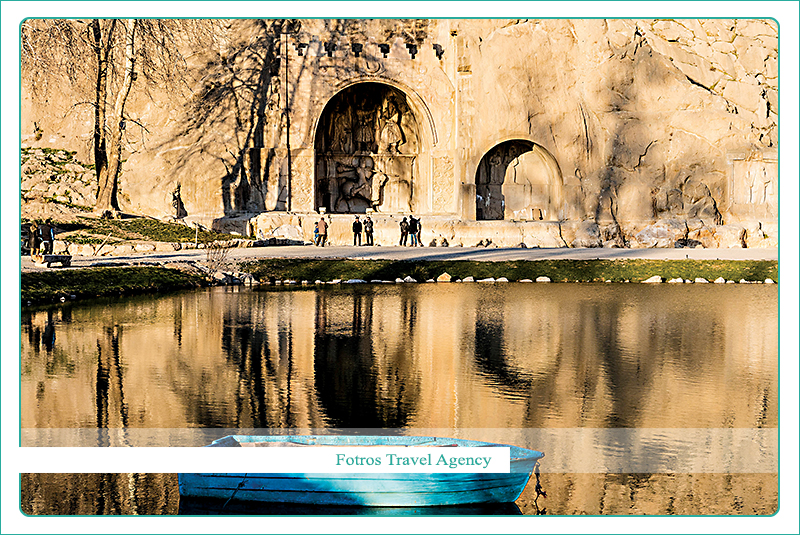
Kermanshah Tourist Attractions
Kermanshah has numerous tourist attractions. Kermanshah is one of the most populated cities in the Western part of Iran. It is known as the historical cities of Kermanshah province, Iran. Kermanshah is famous for its wonderful historical tourist attractions such as Taq-e Bostan, Mount Behistun, Statue of Hercules in Behistun, Shafei Mosque, Safavid Caravansary, Tekyeh Biglarbeygi, Taq-e Gara, Quri Qal'eh Cave, Anahita Temple, Tekyeh Moaven al-molk. Join our Iran Silk Road to visit these places. Following we are going to review the historical tourist attractions of Kermanshah.
Safavid Caravanserai
Safavid Caravansary, also recognized as Shah Abbasi Caravanserai, is located at the Northeast of Kermanshah. This tourist attraction is one of the most famous traditional Iranian Caravanserais. This caravanserai belongs to the Safavid period and is situated in Bisotun. The style and architectural pattern of this Caravanserai is can remind you about the Safavid period. The entrance gate of the Safavid Caravanserai is located on the south side and has seven arches at each side.

Taq-e Bostan
Taq-e Bostan is one of the extraordinary historical monuments and tourist attractions of Kermanshah. It has been told that Taq-e Bostan is the first stone animation in the world. Sassanid petroglyphs and Pahlavi inscriptions, Shapur II and III, Khosrow Parviz, Artaxerxes II coronations are available in Taq-e Bostan. Many mountains and springs are available in this area and Taq-e Bostan was recorded as a national monument in the year 1931 with registration number 172.

Mount Behistun
Mount Behistun tourism attraction is a famous rock relief which includes the narrative of great Achaemenian King; Darius the Great and their exploits around B.C. 500.

Statue of Hercules in Behistun
Statue of Hercules is sculpted out of stone in Seljuq period and when Arsacid conquest the Great Medians. This statue is located at the east-western road of Silk Road or Great Khorasan Road. Statue of Hercules was discovered during Hamedan-Kermanshah road construction in 1958. Statue of Hercules in Behistun has 1.47 meters length and the statue is attached to the mountain from the back side. On the back side of the statue, reliefs and inscriptions in ancient Greek have been inscribed. Under the statue body, there is a relief of a lion, whose length is 200 centimeters from tail to head and the length of its tail is 114 centimeters.

Shafei Mosque
Shafei Jameh Mosque is another tourist attraction which was established in 1945 for Sunni people. Nowadays prayers are held only in the new building of the mosque which is in the style of Turkish mosques. Taking photos from the square and inside the mosque is forbidden.

Taq-e Gara
Taq-e Shirin or Taq-e Gara is a stone structure which belongs to the Sasanian Empire. This tourist attraction is located on the 15th kilometer from Sarpol-e Zahab about five hundred meters walk away from the main road. There are contradictory opinions about the time of its construction. Most archeologists and historians believe that it has been built during the late Sassanid Empire for a variety of reasons.

Quri Qal'eh Cave
Qouri Qala or Qouri Qal’eh cave is one of the largest water caves of the Middle East; this tourism attraction dates back to 65 million years ago. In Qouri Qal’eh cave, is 12 kilometers long and is 3140 meters deep and there are 4 waterfalls in the depths of the ground which distinguishes this cave with other caves. The detection of relics such as plates, bowls, and some coins from Yazdegerd III era specifies its age. Qouri Qal’eh cave has been registered as one of Iran’s seven natural and 54th national relics by the Cultural Heritage Organization on March 17th, 2009.

Tekyeh Biglarbeygi
Tekyeh Biglarbeygi is a monument located in Sarem al-Dowleh Alley. This tourist attraction is known as Biglar Beigi and was built in Qajar era by Abdullah Khan. It is a unique monument because of mirror works. In the western side of the yard, Husseiniyeh is located which is a great mirrored hall. Husseiniyeh is covered with wonderful decorations and numerous inscriptions from Mozaffar al-Din Shah’s reign. At the moment Tekyeh Biglarbeygi is a museum of calligraphy and writing.

Anahita Temple
Tourism attraction of Anahita Temple with its Arsacid architectural style is located in the center of Kangavar City in Kermanshah. Some historians consider this temple as a temple for goddess Anahita. In ancient Iranian belief, before Zoroaster, Anahita has been the goddess of water and a symbol of fruitfulness, love, and friendship. In order to honor this Iranian goddess, various temples and statues have been built in the pre-Islamic period. Pol-e Dokhtar and Qal’eh Dokhtars are also the monuments in the memorandum of this goddess. In numerous cities of Iran such as Azerbaijan, Shush, Hamedan, Kazerun, Kermanshah and Kangavar monuments of Anahita are still available. The Temple of Anahita in Kangavar due to the height of its columns is one of the unique temples in the world. After Persepolis, Anahita Temple is the second stone building in Iran. Temple of Anahita was recorded among the national monuments in 1931 under the number 31.

Tekyeh Moaven al-molk
Moaven al-Molk Tekyeh is a monument and tourist attraction which belongs to the Qajar period. This building is separated into three units of Husseiniyeh, Zeinabiyeh, and Abbasiyeh. According to experts of cultural heritage in Kermanshah, the embossed and semi-embossed tiles with natural colors used in its building are unique in the world. Scenes such as the wars of Ali’s battles, Mohammad against infidels, Karbala events and pictures of ancient Iranian kings are among the carved ones on the tiles. Moaven al-Molk Tekyeh was registered in the list of Iran’s national monuments in 1975 with registration number 945.

Related Tags:
We love to hear your comments